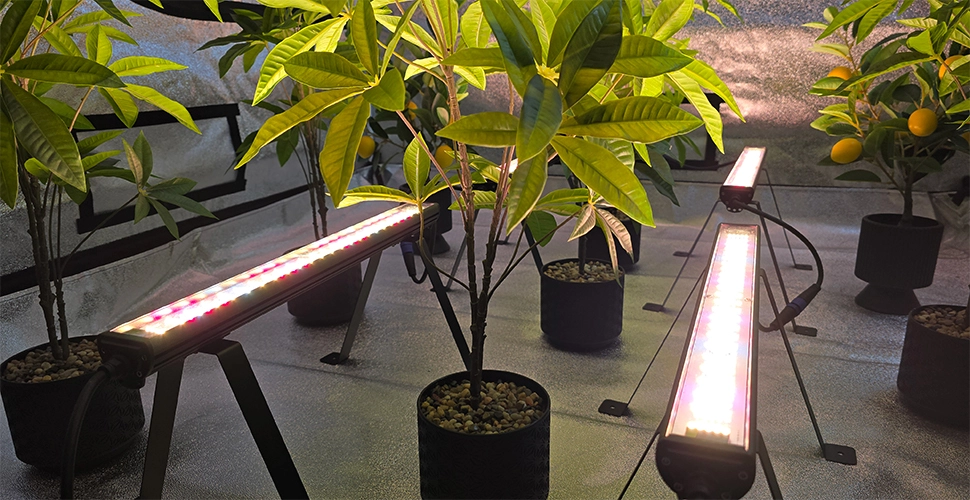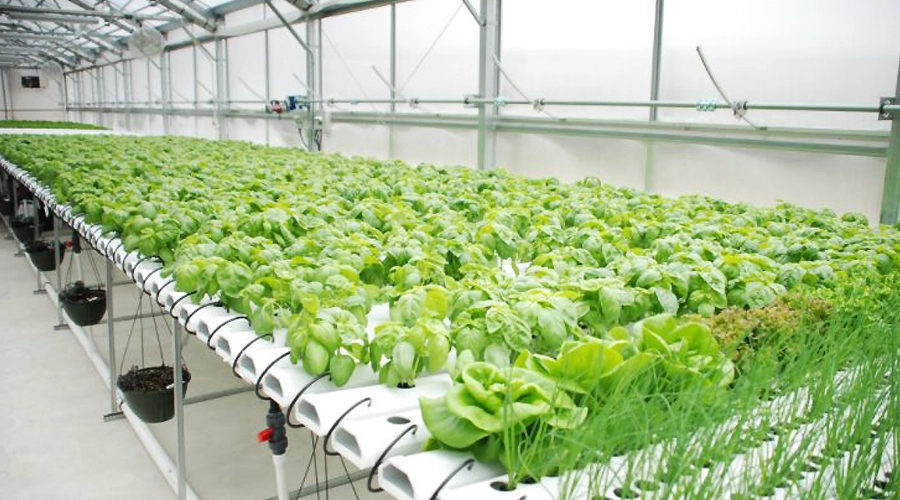Keeping indoor plants can be enjoyable because you have control over their environment. LED grow lights can enhance plant growth, making it even more satisfying.
It has come to our attention that some newcomers are inquiring about indoor grow lights LED and their usage. Is it true that plants grow quicker with constant light exposure? Can I leave my grow light on 24 hours?
Honestly, leaving grow lights on 24 hours is not advisable.
Excessive light can be harmful to plants and can lead to increased electricity consumption, even with a low-wattage bulb. However, it’s not always necessary to have excessive light for your plants.
Although continuous light can boost greenhouse food production, it is essential for plants to have periods of darkness to regulate their growth, repair damaged tissues, and store energy.
Without sufficient dark periods, plants will experience stress and damage, resulting in stunted growth, wilting, and even death.
Have you ever thought about how long to leave a grow light on?

How Long to Keep Grow Lights On?
Typically, the amount of time LED grow lights need to be turned on varies based on the specific needs of the plant being grown.
As a general rule, most plants require approximately 12-16 hours of light and 8-12 hours of darkness each day.
The range of 12-16 hours might be confusing.
Some plants require only 12 hours of light exposure. If your LED grow lights are on for 15 hours, the plant may wither and die due to overexposure to light.
But some plants may need as many as 16 hours of light exposure. If your grow lights only work for 12 hours, the plant may not receive sufficient light and its growth may be hindered.
Light Requirements for Plants
Each plant has a unique requirement for the amount of light it needs.
Many plants need about 12 hours of light per day to grow and thrive, and some even more. This is because they need enough light for photosynthesis.
When your indoor growing environment lacks sufficient light, it’s essential to make use of LED grow lights.
- Roses. In general, rose production can be increased by using continuous light. Shade-tolerant varieties grow well in less than 6 hours of sunlight per day.
- Tomatoes. Tomato plants need a lot of light to produce healthy, tasty fruit. The tomato grow light hours are 12-16 hours per day.
- מלפפונים. Cucumber plants also need 12 hours of light daily to produce healthy, tasty fruit.
- Peppers. Like tomatoes, peppers need about 12-16 hours of light per day to thrive.
- חֲשִׁישׁ. During the growing stage, cannabis plants need 18-24 hours of light per day from indoor grow LED lights. During the flowering stage, cannabis plants need 12 hours of light and 12 hours of darkness per day.
- Succulents. Your clip-on grow lights for indoor plants can work for 14-16 hours per day during the active growing season of your succulents, reducing them to 8-10 hours per day during the dormant season.
- Herbs. For outdoor growing, most herbs need at least 6 hours of direct sunlight per day, while basil requires 8 or more hours of light. Growing indoors allows LED grow lights to work 12-16 hours per day.
- חַסָה. Under indoor grow light kits, seedlings need about 14-16 hours of light per day. As plants mature, they may require slightly less light, about 12-14 hours per day.
- Strawberrie For outdoor growing, you will need about 10-12 hours of light per day. For indoor growing, keep your lights working for 14-16 hours.
Growth Cycle of Plants
The light requirements for plants vary depending on their growth stage.
Plants require different amounts and types of light at each stage of growth, flowering, and fruiting, just as humans require varying types of nutrition at different stages of life.
Now, we can proceed with learning about the required amount of light for different stages of plant growth.
חֲשִׁישׁ
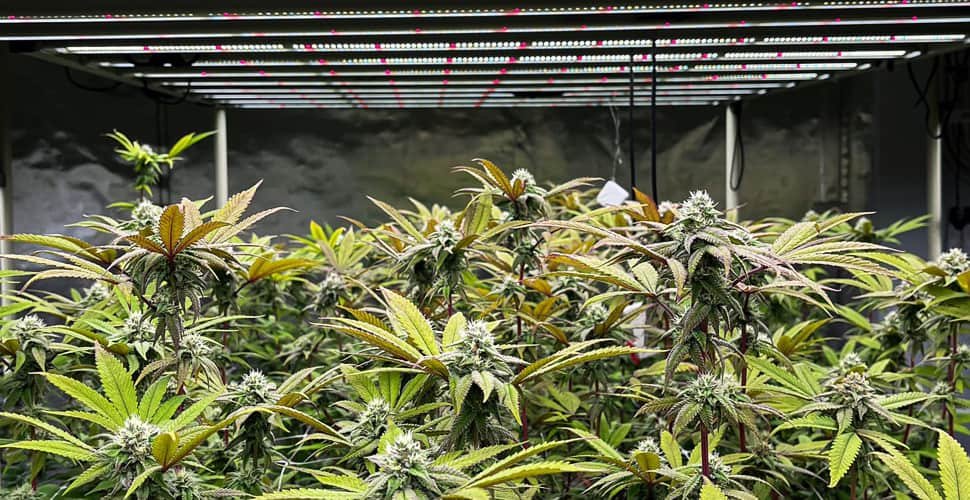
Vegetative Stage
Your growing weed indoors light needs to work for 18-24 hours during the period when the plant is growing leaves and stems.
This extended period of light allows the plant to photosynthesize and produce the energy needed for the growth and development of leaves and stems.
In terms of light intensity, cannabis plants require 1000-1500μmol/m²/s during the growth phase. The specific light intensity required may depend on factors such as the genetics of the plant, the growing environment, and the specific growing method used.
Providing the right amount and intensity of light at this stage is crucial to ensure healthy plant growth and development. That’s why choosing the right LED grow lights for your plants is a key point for growing cannabis indoors.
Insufficient light can weaken the plant and result in lower yields, while excessive light can stress and harm the leaves, negatively affecting growth.
Flowering Stage
When cannabis starts producing buds, the cannabis plant needs 12 hours of light and 12 hours of darkness per day. This can come to trigger the production of flowers or buds to produce flower buds.
In terms of light intensity, cannabis plants require 600-800μmol/m²/s during the flowering stage. This level of light is slightly lower than that required for the growth phase, as the focus of the plant has shifted from asexual reproduction to flowering production.
During the flowering stage, it is crucial to maintain a consistent 12/12 light cycle. Any disruption to the cycle may have a negative impact on the plant’s ability to flower or produce buds.
תותים
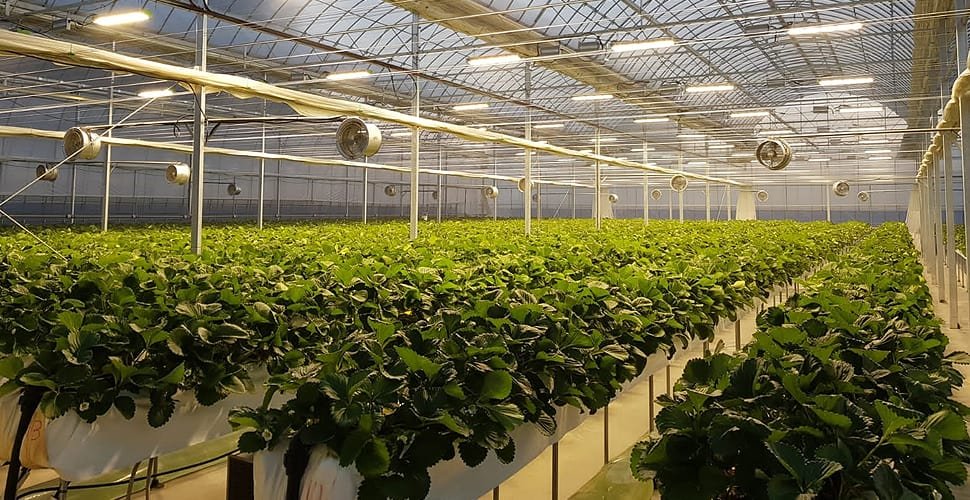
Even when growing strawberries indoors with commercial greenhouse lighting, there are different requirements for the light cycle of strawberries.
Germination Stage
Starting from the seed, strawberries need low to medium light. It is best to provide them with about 12-16 hours of light per day.
Vegetative Stage
During the growth stage phase, strawberries require higher light levels. It is recommended to provide them with 14-18 hours of light per day.
Flowering Stage
Strawberries need more light than in the growing stage, ideally 16-18 hours of light.
Fruit Ripening Stage
Strawberries rushing into the fruiting stage need moderate to high light levels. Please keep your lights working for 12-14 hours.
As your plants grow, it’s important to monitor their progress and make adjustments to the LED grow lights. This includes adjusting the light level and height to meet their changing light requirements at each stage of growth.
Both wild strawberries and June strawberries have varying light requirements. To ensure your plants get the right amount of light, research their specific needs.
Succulents
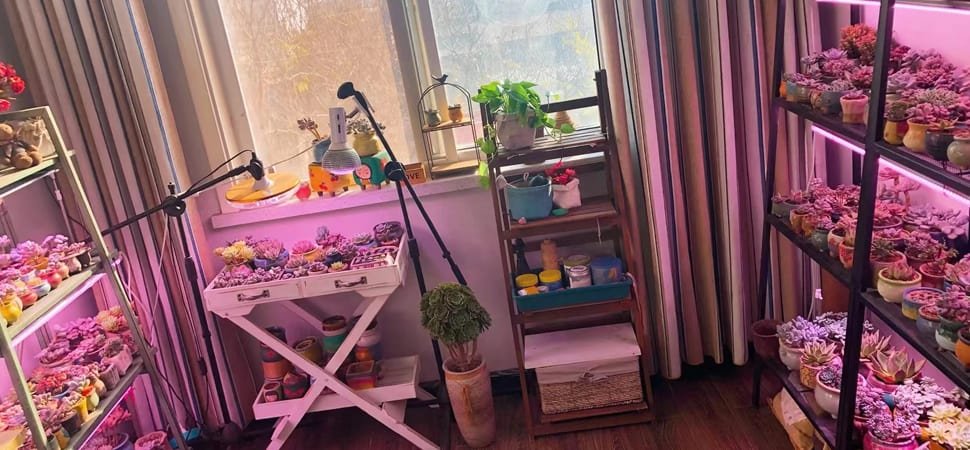
For succulents, it’s best to give them 14-16 hours of light per day when they’re actively growing, and then reduce it to 8-10 hours per day when they’re in their dormant period.
Germination Stage
Succulents need bright, direct light for successful germination. Indoor house plant grow lights with an intensity of 200 to 400µmol/m²/s and a color temperature of 5000K to 6500K is ideal for this stage.
Vegetative Stage
In this stage, succulents require more intense light than in the germination and seedling stages. Indoor herb growing light with an intensity of 400 to 600µmol/m²/s and a color temperature of 5000K to 6500K is ideal for this stage.
Flowering Stage
At this stage, succulents need the most intense light. Indoor growing lights for plants with an intensity of 600 to 800µmol/m²/s and a color temperature of 2700K to 3000K are ideal for this stage.
Some types of succulents can tolerate much less light. It’s best to research the specific needs of your plants to make sure they are getting the right amount of light.
To keep your succulents healthy, make sure they are not exposed to excessive direct sunlight. If you observe any indications of sun damage, such as brown spots or leaf burning, it might be necessary to relocate your succulents to a slightly shaded spot.
Can Plants Get Too Much Light?
Have you ever heard the saying that in order to achieve big things, you can’t expect fast results and if you only focus on small benefits, you won’t be able to achieve your ultimate goal?
As we mentioned, some newcomers ask whether it is possible to leave a grow light on 24 hours a day so that the plants can quickly reach the development and fruiting stage.
He only wants to reach the plant’s maturity quickly and ignores the problem that too much light stresses plants.

Photo-Oxidative Stress
Running LED grow lights 24/7 means that intense light exposure can cause damage to plant cells by producing reactive oxygen species (ROS). This can lead to reduced growth, stunting, and even cell death.
Degradation of Chlorophyll
Chlorophyll is the pigment responsible for capturing light energy in photosynthesis. Excessive light exposure can lead to the breakdown of chlorophyll in leaves, which may result in reduced photosynthetic capacity and slower growth.
Burnt Leaves
Leaves of plants may be burnt or scorched by leaving lights on 24/7. Reduced photosynthetic capacity of plants.
Less Efficient Use of Water
Plants exposed to too much light may also lose more water through transpiration, and plants will be at risk of drought stress.
Reduced Nutrient
High light levels can also cause damage to the roots of plants, which may reduce their ability to absorb nutrients from the soil and stunt growth and development.
סיכום
To achieve the best results when using LED grow lights, it’s important to consider factors like the plant type, growth stage, and light intensity.
For the vegetative stage, most plants need 14 to 18 hours of daily light, while the flowering stage requires 12 hours of light per day.
To ensure that plants receive the appropriate amount of light for their unique requirements, it is crucial to monitor them regularly and adjust their lighting schedules as necessary.
And you should keep in mind that too much light can be detrimental to plants, resulting in stress and hindered growth.
For consistent light and adequate rest time for plants, it is advisable to use a timer or LED grow light controller.
ה בקר אור גידול LED from Auxgrow is highly compatible, working with 90% of the LED grow light brands available today.
If you’re interested in controlling your plant lights’ operating hours with this product, please reach out to us for more information.
ג'ייס
כמנהל שיווק דיגיטלי ב-AUXGROW, ג'ייס משלב תשוקה למערכות הידרופוניות ומומחיות באורות LED לגידול. עם ניסיון מעשי והבנה עמוקה, ג'ייס מנחה אותך בעולם של טיפוח בר קיימא.




